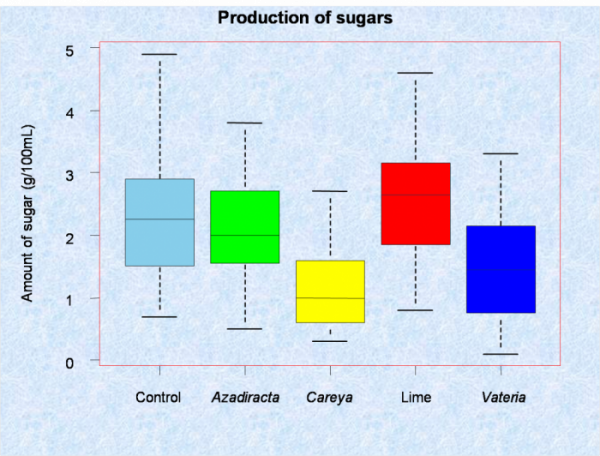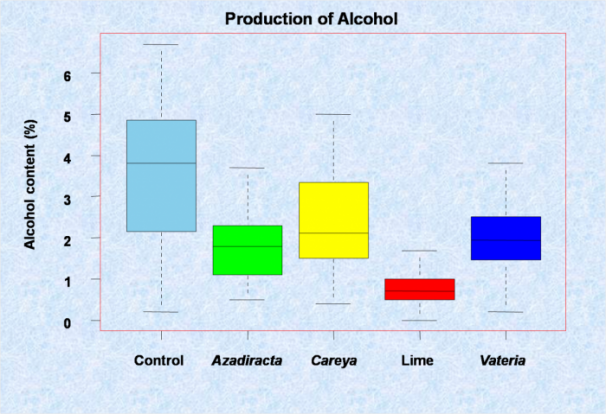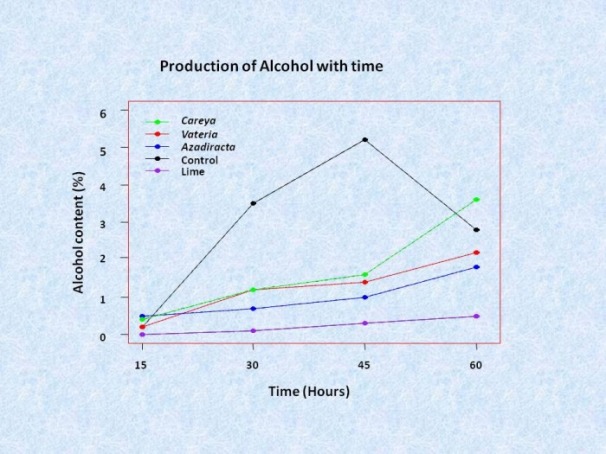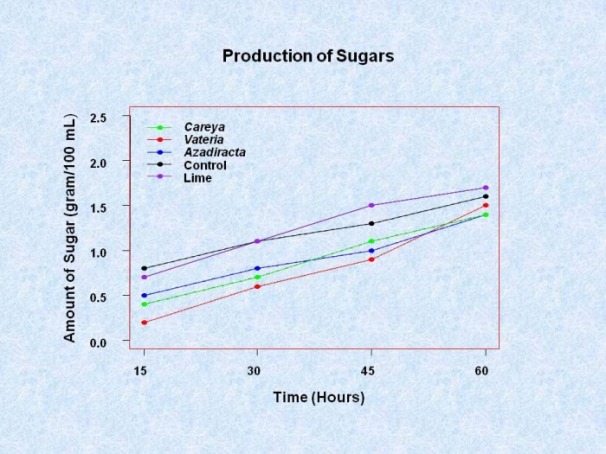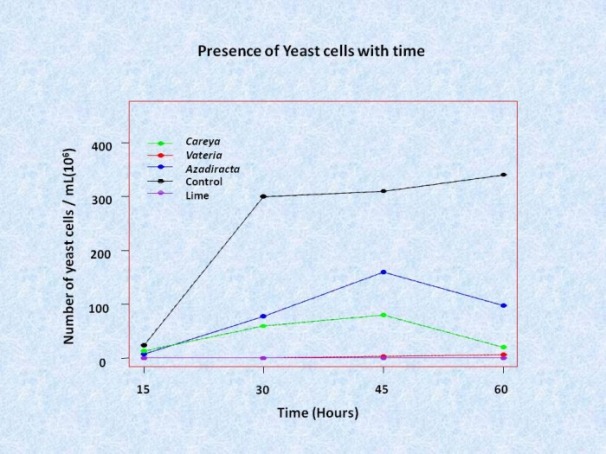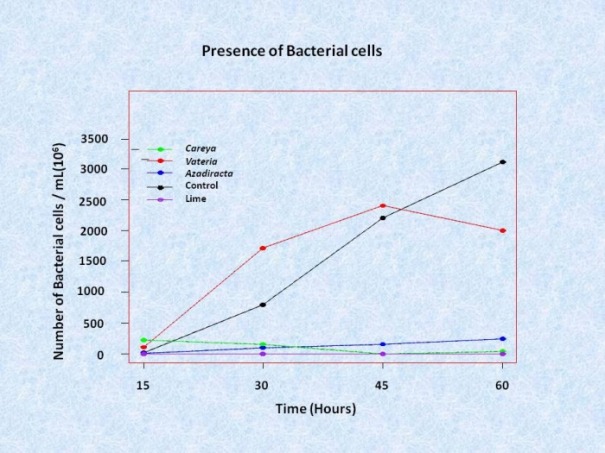Graphs
Figure 6: Amount of sugars produced in the palmyrah sap with different treatments
Figure 7: Amount of alcohol produced in the palmyrah sap with different treatments
Figure 8: Presence of yeast cells in the sap of palmyrah with various treatments
Figure 9: Presence of bacterial cells in the sap of palmyrah with various treatments
Figure 10 : Production of Alcohol in the sap of palmyrah with time
Figure 11: Production of sugar in the sap of Palmyrah with time
Figure 12: Number of yeast cells found in the Palmyrah sap, with time
Figure 13 : Number of bacterial cells in the Palmyrah sap with time
During fermentation carbohydrates are converted to alcohols and carbon dioxide or organic acids by microorganisms such as yeasts, bacteria, or a combination of there two, under anaerobic conditions. Palmyrah sap is a good sugar source for the microbes.
The alcohol content of Palmyrah sap observed in Vateria copallifera, Careya arborea, Azadiracta and control were higher than that of Lime. In all the treatments, amount of alcohol produced increased with time, except control. The degree of inhibition of fermentation varies among the different substances used. Higher inhibition of fermentaion by lime might be due to the alkaline pH.
In all the treatments, amount of sugar produced increased with time. Higher amount of sugar was produced after 30 hours, when lime was used. Vateria and Careya showed a considerable reduction in the amount of sugar when compared to that of control. But lime showed comparatively higher sugar production than all the other treatments.
Yeast cells were found in almost all the treatments. In all the treatments yeast showed a slightly slower growth rate when compared with control. When Azadiracta and Careya were used , number of yeast cells increased upto 45 hours and then it started to decline. With lime and Vateria, number of yeast cells was found to be very low throughout the experiment. Lime and Vateria are able to delay the multiplication of yeast cells. But very low amount of yeast cells were found in the limed pot. This may be due to the alkaline pH of lime.
Bacterial cells were found in almost all the treatments. When lime, Azadiracta and Careya were used, comparatively lower amount of bacterial cells was observed than the control and Vateria. With Vateria, bacterial cells increased up to 45 hours and then they started to decline. But in the control treatment, number of bacterial cells increased continuously throughout the experiment. Bacterial cells were found after 15 hours to be in order of 107 – 108 cells per mL in all the treatments except with lime. Number of bacterial cells was very much lower (1.12 * 104 cells /mL) and this number gradually decreased with the time. The estimate of bacteria in these samples might not be a true estimation because of the particular medium for their isolation.
The alcohol content of Palmyrah sap observed in Vateria copallifera, Careya arborea, Azadiracta and control were higher than that of Lime. In all the treatments, amount of alcohol produced increased with time, except control. The degree of inhibition of fermentation varies among the different substances used. Higher inhibition of fermentaion by lime might be due to the alkaline pH.
In all the treatments, amount of sugar produced increased with time. Higher amount of sugar was produced after 30 hours, when lime was used. Vateria and Careya showed a considerable reduction in the amount of sugar when compared to that of control. But lime showed comparatively higher sugar production than all the other treatments.
Yeast cells were found in almost all the treatments. In all the treatments yeast showed a slightly slower growth rate when compared with control. When Azadiracta and Careya were used , number of yeast cells increased upto 45 hours and then it started to decline. With lime and Vateria, number of yeast cells was found to be very low throughout the experiment. Lime and Vateria are able to delay the multiplication of yeast cells. But very low amount of yeast cells were found in the limed pot. This may be due to the alkaline pH of lime.
Bacterial cells were found in almost all the treatments. When lime, Azadiracta and Careya were used, comparatively lower amount of bacterial cells was observed than the control and Vateria. With Vateria, bacterial cells increased up to 45 hours and then they started to decline. But in the control treatment, number of bacterial cells increased continuously throughout the experiment. Bacterial cells were found after 15 hours to be in order of 107 – 108 cells per mL in all the treatments except with lime. Number of bacterial cells was very much lower (1.12 * 104 cells /mL) and this number gradually decreased with the time. The estimate of bacteria in these samples might not be a true estimation because of the particular medium for their isolation.
